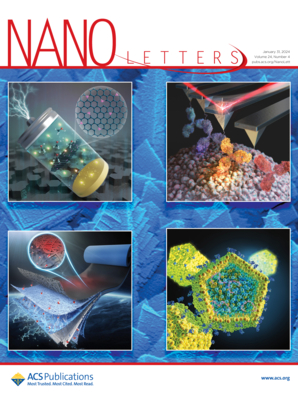各向异性外延应变对[111]取向Pt/Co异质结构垂直磁化的全电操纵
IF 9.1
1区 材料科学
Q1 CHEMISTRY, MULTIDISCIPLINARY
引用次数: 0
摘要
通过自旋轨道力矩(SOT)有效操纵垂直磁化,为磁存储器和自旋逻辑器件带来了巨大前景。然而,对于具有高度对称性的传统材料来说,垂直磁化的无场 SOT 开关仍然是一个挑战。本研究阐明了在外延[111]取向铂/钴异质结构中对垂直磁化的完全电操控。由于[112]和[110]方向之间的不匹配,较大的各向异性外延应变诱导了从理想的 C3v 到 C1v 的对称性转变。各向异性应变还沿着[112]方向产生了值得注意的面内磁化分量,进一步打破了磁对称性。值得注意的是,在 393 K 下的高温性能凸显了应变引起的面内对称性破坏的稳健性。此外,还在单个 SOT 器件中演示了八种布尔逻辑运算。这项研究提出了一种利用外延应变打破面内对称性的方法,为实用 SOT 器件开辟了一条新途径。本文章由计算机程序翻译,如有差异,请以英文原文为准。
![Full Electrical Manipulation of Perpendicular Magnetization in [111]-Orientated Pt/Co Heterostructure Enabled by Anisotropic Epitaxial Strain](https://img.booksci.cn/booksciimg/2025-4/2025041610204497722550.png)
Full Electrical Manipulation of Perpendicular Magnetization in [111]-Orientated Pt/Co Heterostructure Enabled by Anisotropic Epitaxial Strain
The effective manipulation of perpendicular magnetization through spin–orbit torque (SOT) holds great promise for magnetic memory and spin-logic device. However, field-free SOT switching of perpendicular magnetization remains a challenge for conventional materials with high symmetry. This study elucidates a full electrical manipulation of the perpendicular magnetization in an epitaxial [111]-orientated Pt/Co heterostructure. A large anisotropic epitaxial strain induces a symmetry transition from the ideal C3v to C1v, attributed to the mismatch between [112] and [110] directions. The anisotropic strain also generates a noteworthy in-plane magnetization component along the [112] direction, further breaking magnetic symmetry. Notably, the high-temperature performance under 393 K highlights the robustness of strain-induced in-plane symmetry breaking. Furthermore, eight Boolean logic operations have been demonstrated within a single SOT device. This research presents a method for harnessing epitaxial strain to break in-plane symmetry, which may open a new avenue in practical SOT devices.
求助全文
通过发布文献求助,成功后即可免费获取论文全文。
去求助
来源期刊

Nano Letters
工程技术-材料科学:综合
CiteScore
16.80
自引率
2.80%
发文量
1182
审稿时长
1.4 months
期刊介绍:
Nano Letters serves as a dynamic platform for promptly disseminating original results in fundamental, applied, and emerging research across all facets of nanoscience and nanotechnology. A pivotal criterion for inclusion within Nano Letters is the convergence of at least two different areas or disciplines, ensuring a rich interdisciplinary scope. The journal is dedicated to fostering exploration in diverse areas, including:
- Experimental and theoretical findings on physical, chemical, and biological phenomena at the nanoscale
- Synthesis, characterization, and processing of organic, inorganic, polymer, and hybrid nanomaterials through physical, chemical, and biological methodologies
- Modeling and simulation of synthetic, assembly, and interaction processes
- Realization of integrated nanostructures and nano-engineered devices exhibiting advanced performance
- Applications of nanoscale materials in living and environmental systems
Nano Letters is committed to advancing and showcasing groundbreaking research that intersects various domains, fostering innovation and collaboration in the ever-evolving field of nanoscience and nanotechnology.
 求助内容:
求助内容: 应助结果提醒方式:
应助结果提醒方式:


